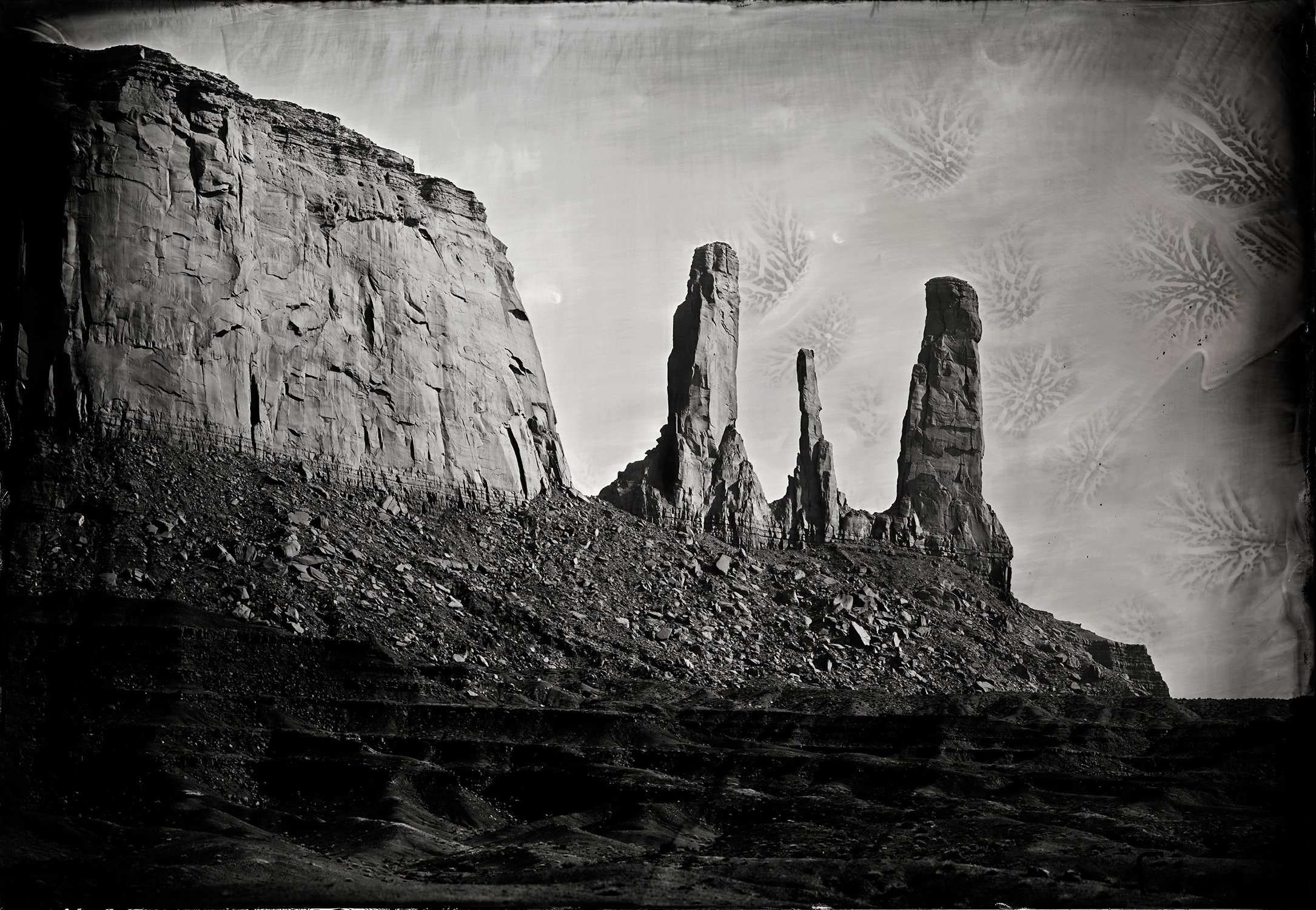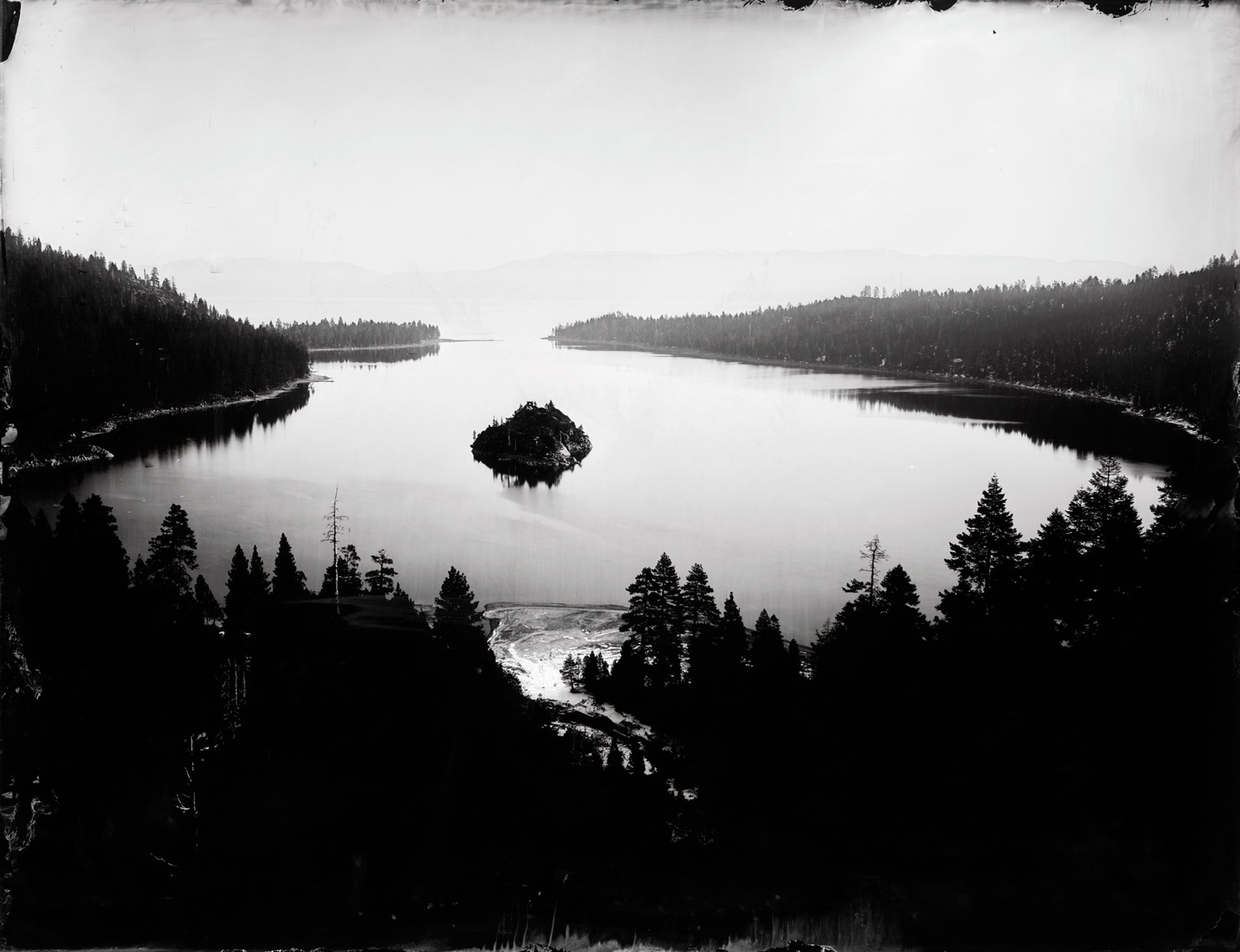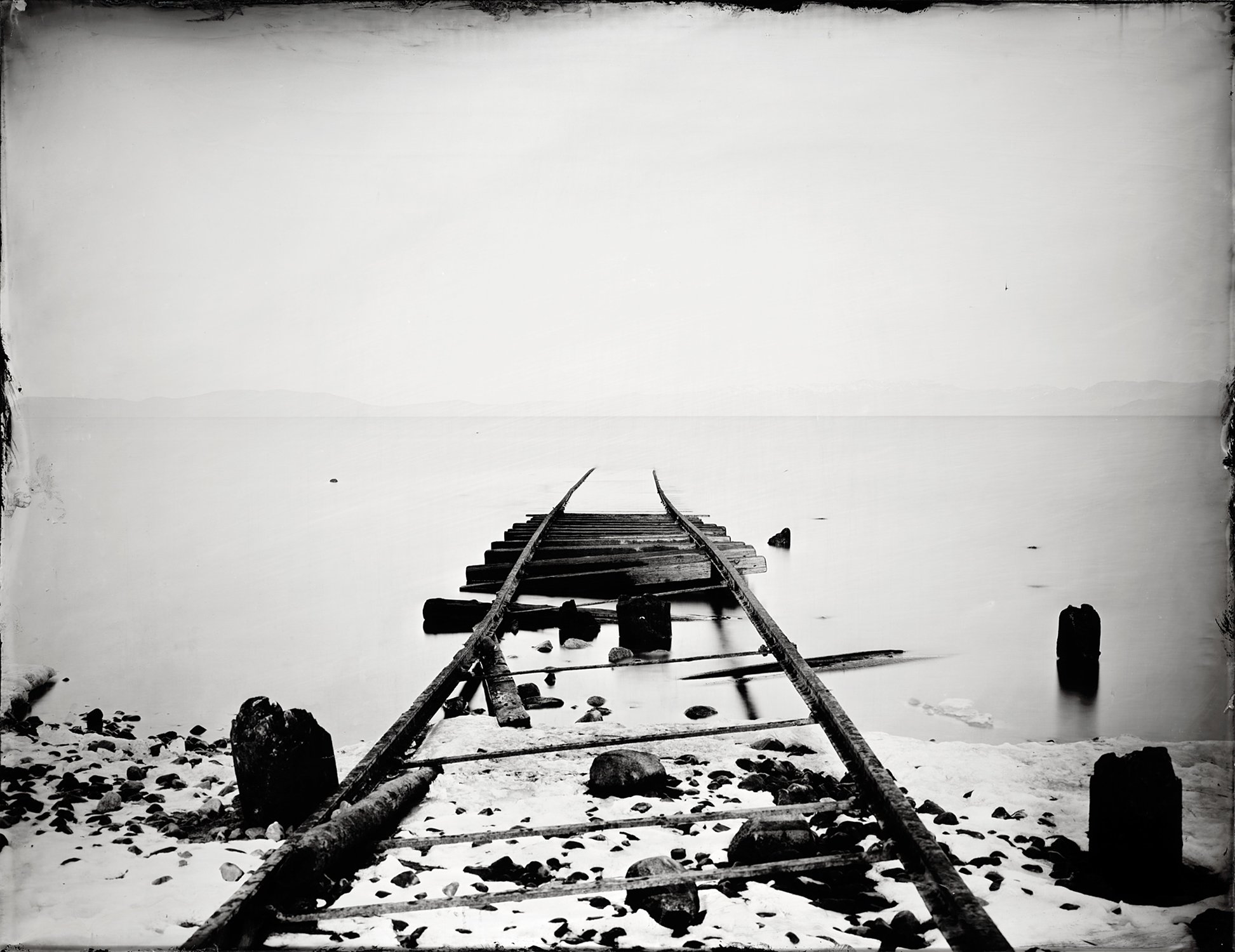Featured Photographer: Ian Ruhter - Never Surrender
Ian Ruhter is a fine art photographer, making portraits and exploring the landscape using the wet plate collodion process, who has become internationally known for creating the world's largest photographs with this historical medium. He spent his youth growing up with learning disabilities, and found reading and writing to often be problematic. At the age of 25 he discovered photography and quickly realized that it could be a powerful means of communication that could provide him a voice in ways that he hadn’t had in the past. As he learned about photography and progressed his skills with the medium, he began to think that using it as a means to make a living would benefit him by allowing him to both express himself and provide for his life. It was at this point that he set out working commercially and quickly picked up the clothing and shoe brand, Vans. As a client they kept him quite busy shooting catalogs and ad campaigns which eventually led to other editorial jobs that allowed him more creative freedom. Even though he was beginning to pick up other clients, Vans kept him on as a salaried photographer who provided year round work to him. However, building and running a successful commercial practice became a more unfulfilling endeavor over time, and Ian began to explore other options within the photographic industry. Creativity and uniqueness became something for him to now set his sights on.
On Ian’s search for a creative and unique outlet he soon discovered the wet plate collodion process, a 19th century photographic process using raw materials, such as silver nitrate, to make your own light sensitive film to coat either a metal or glass plate - with those on metal known as tintypes, and those on glass as ambrotypes. He discovered this age old photographic process via the modern technology of the internet. After learning the history and technical process of this medium by himself, he took a workshop from photographer William Dunniway. After time and testing of chemistry and materials, Ian concluded that ambrotypes were to be the main focus of his work, for their inherent beauty and detail. Later, Ian decided to put all of his commercial work behind him and dedicate his energies to working in this medium, dubbing his new project, Silver & Light. Starting where one does in this process by shooting 4x5” and 8x10” plates, Ian quickly felt that more could be accomplished, and immediately found a desire to make images as large as he possibly could. After experimenting with scanning the smaller plates and making enlargements, he decided that this simply was not enough for him, wanting to keep the look and feel of the original. The tactile quality of these originals was unmistakable and keeping this feeling became paramount in his work. The desire to make plates that were 4x5 feet, instead of 4x5 inches became his goal and his passion. Without thinking of what a technically daunting task this would be, he simply charged forward into his goal with no excuses standing in his way.
“Once you do what is within you, it will be so unique and so different, that it truly will be yours.”
Ian soon realized the difficulties of photographing plates with this process at the desired size brought about the need for not just a massive camera, but a darkroom space large enough to develop them. After telling his father about the ideas he had, Ian’s father felt that a box-style truck of some sort would solve both problems. It could be used to mount a lens at the rear of the vehicle and hold an unexposed plate inside during the actual shooting time, and then use it as a darkroom for processing the very plate that was exposed inside. This also accomplished the basic need of mobility in getting this massive camera from one place to the next with relative ease for something this large. The wet plate process requires specific chemistry and precise time and organizational skills in order to create a successful photograph, with the coating of the plate, exposure, and processing all happening in roughly a ten minute space of time. The camera truck, performing this double duty, was born after the purchase of an old UPS sized delivery truck at auction. After spending an ever increasing amount of preparation time in ordering chemistry, cutting and cleaning plates for coating and exposure, and storing them safely, Ian’s time actually out in the field making photographs becomes limited and extremely important. Ian set a goal of making at least one plate a day keeps the process slow and methodical, but has been the necessary time frame needed to pace himself in creating successful plates worthy of exhibition.
Once Ian had practiced and perfected his process using collodion and the camera truck, the interest in documenting what he was doing became quite apparent to him. Treating his personal project the same way his commercial clients had documented and promoted themselves seemed to be a natural extension of sharing his work with the world. The idea of photographing with a 19th century process and using a camera truck to make massive original plates was difficult to articulate to people without seeing it firsthand, and filming his work became a part of the daily routine. More importantly though, it showed people why. Why do something like this when you could simply shoot digitally and use Photoshop to convert, distress, and create something that looks very similar? Ian let viewers in to know where his heart was with the creation of these images, showing there can be another way of doing things not so obvious, and blazing your own trail in the goals you’ve set forth for yourself. When the original film, Silver & Light, was released, Ian had hoped that if he could get around ten thousand views he would call it a success. Within two weeks of its release the film garnered over one million views, going viral, and Ian found himself receiving thousands of emails from people expressing their admiration for his efforts and the inspiration he brought to their lives. Subsequently, Ian has continued to have his various wet plate work filmed as an ongoing record of his efforts.
Ian’s philosophy and ideas behind using the wet plate collodion process at this scale come from his original dissatisfaction of making images in the commercial world, seeing them all too often as lies. Not wanting that to be his legacy, finding something that fed his soul and excited him became extremely important. This process enables him to photograph people and places with an unblinking honesty, creating one-of-a-kind original art - seeing a correlation to other forms of art, such as painting or sculpture. Originality and finding a concept that he could embrace on his own became the substance of his passion for the art that he creates. Ian says, “Once you do what is within you, it will be so unique and so different, that it truly will be yours.” According to Ian, no amount of copying or mimicking another's work will ever give you the satisfaction that following your heart can.
Among the many things Ian has learned in making plates as large as he does, he has discovered that the costs, labor, and time required increase exponentially with each upgrade in size and quality. There was a lot of trial and error early on in perfecting his workflow in practically every part of the process. Working with collodion is a difficult process to master in even the best and most comfortable of situations. Taking these steps outside and working out of a truck in the field to produce imagery gets harder with each new element introduced. As his practice has grown, the need to be hands on with framing, storage, transportation and care has evolved in order to control the high cost of producing his work and has been a learning experience every step of the way. A recent project of working in Dubai meant engineering crates to ship 20 4x5 foot glass plates back and forth to the U.S. that were able to withstand and overcome things like forklifts and transportation via plane over thousands of miles. Controlling these variables is important considering the plates he creates range from 27x35” to 48x60” in size and can weigh as much at 75 pounds each.
While there is occasionally collaboration with other artists, filmmakers, and people who support his projects, Ian’s assistant, Will Eichelberger is the one permanent member of his team. A loyal and ardent supporter of Ian and his philosophy (and a gifted artist in his own right), Will is instrumental in Ian’s projects, even when money is tight and the work becomes grueling. Having a devoted right-hand man with him while making plates has enabled Ian to flourish as an artist, and fully understands the value that Will brings to his practice. Having like-minded people who know and work with you is an extremely important aspect that Ian does not take for granted.
“Silver Trees” - 27”x35" Ambrotype - 2015
“Cascade Lake” - 48''x60'' Tintype - 2013
Over the years, Ian has taken on many special projects in the pursuit of his passion. Some such places of interest have sent him into photographic hallowed ground, by spending some concentrated time photographing in Yosemite and walking in the footsteps of so many distinguished photographers before him. Another significant trip sent him to Monument Valley, after a call from The Travel Channel suggested filming him and his work while making plates there. Also, the aforementioned journey into the UAE for the Exposure Photography Festival at the invitation of a gentleman who had viewed his short films, meant making plates in Dubai under vastly different cultural differences. Shipping not just plates and gear for the Festival, but chemistry into the Middle East proved to be an experience in itself. Everything except the truck itself was sent, resulting in crates weighing 4000 pounds being transported to the festivals location. Once there, Ian discovered that driving a truck large enough to shoot the plates he wanted to make required an official police escort everywhere he went. This, coupled with the fact that everyone would break five times a day for prayer, meant that the pace of the work would often slow down to a crawl. One last special project worth mentioning, and one very dear to Ian, is his Suspended in Time body of work. Inspired by the advances of Eadweard Muybridge, a pioneer in photographic studies of motion, Ian set out to capture motion by freezing it in time using the wet plate process. Since the exposure times for the plates are normally quite long, being that the film speed is usually around ISO 1, Ian used modern strobes to light and freeze the action of skateboarders and snowboarders in mid air - something not so successfully done before. This project in particular is one that Ian is planning on returning to in order to accomplish even larger plates of this type.
“Ted” - 8’’x10’’ Ambrotype - 2014
Not being one who sits back and reflects on his accomplishments, Ian is always trying to break new ground and propel his craft forward. Making plates even larger than the 48x60” size was something thought about for a couple of years before he finally made a concerted effort to accomplish this incredible task. While previously photographing in Bombay Beach, CA, a town on the edge of the Salton Sea, Ian had met and made a portrait of a 97 year old gentleman by the name of Ted. Revisiting this area two years later, Ian discovered that Ted had now moved on to nearby Slab City, an unincorporated town containing a poverty stricken group of about 150 permanent residents. This sparked his idea to take over an abandoned house and make it into the camera, just as the truck was made into a camera before. Ted was to be the subject, a homeless man being photographed by an abandoned home. Feeling an emotional and visceral tug from this concept, Ian and his team did the work of mounting his lens onto the front of the house and making the interior light tight in order to make the exposure and then process the plate itself. After trial runs and figuring out the exposure, Ted was sat down in the front yard of the house and the final exposure was made. The result is the world's largest ambrotype ever made, measuring 66x90” and weighing nearly 200 pounds. Several more plates were then made of other nearby residents.
At this point Ian had been representing himself throughout his wet plate career, and needed to find a way to bring in much needed funds for his projects. After an interview for the L.A. Times by photographer Barbara Davidson, Ian asked if she could help with an introduction to David Fahey of the Fahey/Klein gallery in Los Angeles. After a brief email exchange, Ian found himself sitting in the gallery negotiating representation of his work with the gallery. During Ian’s first exhibition at Fahey/Klein in 2014, the gallery was also visited by James Danziger of Danziger Gallery, in New York City. Shortly thereafter, a deal was struck for East Coast representation of Ian’s photographs and a NYC exhibition was quickly mounted. While Ian has been beyond grateful for the interest and support of his work, the idea of making prints from his originals meant more to the galleries in terms of sales, somewhat tarnishing what Ian felt was most important - that being the original plates themselves. Still, knowing that prints make his work more accessible to collectors, it comes with mixed emotions in the actual selling of his imagery. Editioned prints are what help offset the costs associated with keeping his projects going, but it has been a difficult road in accepting this fact. For Ian, it has always been about the original object created with his process, and the appreciation of that object is the most powerful part of the end result. Thankfully, a 2018 exhibition at Art Ventures in Menlo Park, California, featured his original plates with the unmistakable tactile quality that hooked Ian at the beginning of his career. Being that they are predominately a gallery representing painters, the one-of-a-kind idea is no stranger to them. Still, the hopes for showing an all original plate exhibition in a museum of some sort has become a new goal. Possibly one that would include all of his cameras, tools of the wet plate trade, and perhaps even the camera truck itself as part of the exhibition.
For Ian, the goal has always been to create original art objects. Future projects look to include photographing directly onto gelatin silver papers, rolled out and exposed inside of the camera truck, in order to create one-of-a-kind negative prints in sizes similar to the plates being made now. There is also the potential to continue the work he had started with his Suspended in Time collection, the concept of freezing and capturing motion with wet plate collodion. We may also see a film about Muybridge via the photographic relationship Ian has cultivated with Gary Oldman by teaching him the wet plate process. Whatever happens happens next for Ian Ruhter will most certainly be an inspirational and creative endeavor, for he is definitely not planning on stopping anytime soon. Keep watching for more, and explore more of his work and short films about the process on his website www.ianruhter.com!
Gallery
ABOUT THE AUTHOR
Michael Kirchoff is a photographic artist, independent curator and juror, and advocate for the photographic arts. He has been a juror for Photolucida’s Critical Mass, and has reviewed portfolios for the Los Angeles Center of Photography’s Exposure Reviews and CENTER’s Review Santa Fe. Michael has been a contributing writer for Lenscratch, Light Leaked, and Don’t Take Pictures magazine. In addition, he spent ten years (2006-2016) on the Board of the American Photographic Artists in Los Angeles (APA/LA), producing artist lectures, as well as business and inspirational events for the community. Currently, he is also Editor-in-Chief at Analog Forever magazine, and is the Founding Editor for the online photographer interview website, Catalyst: Interviews. Previously, Michael spent over four years as Editor at BLUR magazine. Connect with Michael on his Website and Instagram!

















